Sorted by date Results 126 - 150 of 150

October of 1913 was a triumphant time for Professor James Dryden, the poultry specialist at Oregon State University (or Oregon Agricultural College, as it was then called). His name was in newspapers nationwide, in glowing tribute after glowing tribute to his success. One of his experiment-station hens, the prosaically named C-521 (later renamed Lady MacDuff), had just shattered the world record for egg production with a stunning 303 eggs in a year, breaking the 300-egg barrier for the first...

Next time you're in the neighborhood of Portland's Pioneer Courthouse Square, take a minute to look at the wrought-iron fence and archway at its south end. Looks a little out of place, doesn't it? That ironwork is all that's left of what was probably the grandest hotel in Oregon history. The Portland Hotel started as a railroad baron's scheme in the mid-1880s, and was opened in 1890 - a riotously colorful yet stolidly tasteful stone palace of hospitality, at the dawn of some of the most...

Things looked grim for the Prineville Nine that summer day in 1910. The little high-desert town's baseball team was getting its clock cleaned by the Silver Lake ball club. The score was nine-zip, and the game was only half played. It was shaping up to be a bloodbath. The game was the third in a best-of-three tournament, a sort of good-natured grudge match between the two central Oregon towns. Prineville was playing host, and had invited Silver Lake to bring its best and its brightest, its...

CONTINUED FROM LAST WEEK The trial started on July 27 with the state presenting its evidence. It looked pretty damning, at least at first. The physician who was called to help the dying Harry Agee testified that as far as he could tell, Louise's side of the bed had not been slept in; the pillow was still fluffy. Klecker, the music teacher, took the stand and told his stag-magazine story about Louise's unrequited passion for him. He went on to "confess" that they had been "inappropriately...

It was a little after 10 p.m. on a Friday evening in the summer of 1921. In their little house on Druid Street in the St. Johns neighborhood of Portland, Robert Green and his family were getting ready for bed when they heard the screams. Rushing to the front porch, they found their neighbor, Ann Louise Agee, in her nightclothes, wild-eyed and disheveled. "Help! Come quick! They're killing Harry!" she screamed. Green looked across at the Agee home. From where he stood, by the light of streetlamps...

When you're watching a melo-drama, you know right away who the villain is. That's him over there, twirling a sinister handlebar moustache beneath a sleek silk hat and telling the pretty widow and her nine orphan children to kiss their beloved homestead goodbye. But that's melodrama, right? And the next scene is always one in which the hero foils the villain's evil plan. But this scene wasn't melo-drama. It was real life. The widow was Mrs. Mary Jane Balch, wife of the first man hanged in the...

A few dozen miles southwest of Baker City, if you know right where to look, you just might stumble across a few weatherbeaten gravestones - all that's left of an old cemetery. And that old cemetery is all that's left of the biggest city in Oregon, a teeming rough-hewn metropolis of 6,000 souls that was called Auburn, Oregon. Auburn was Ground Zero in the eastern Oregon Gold Rush. It was a massive mining camp, pure and simple. It was founded in the spring of 1861, and by 1864 it was already...

Ninety-eight years ago, in a logging camp deep in the forests of British Columbia, a logger in a funny hat walked up to a big stump, an ax in his hand. Taking off the hat - it was a battered bowler, an old-fashioned dandy's hat even in 1923 - he laid it on the stump, set a nail in it, and drove it in. Then he turned and walked away. Probably he walked straight to the logging locomotive for his last ride into town. Nailing the hat to the stump was a symbolic act - Stewart H. Holbrook was...

On the morning of April 23, 1936, the city of Portland was proudly preparing to launch its new harbor patrol boat, the Jack Luihn. It was going to be a big deal. Mayor LaGuardia of New York City was in town, and had been invited to come to the event. And the boat itself was truly revolutionary. Oregon's own wizardly inventor The Jack Luihn was the brain-child of one Victor Wiegand Strode, an inventor with a remarkable flair. Looking back on the historical record, the picture one gets is reminisc...
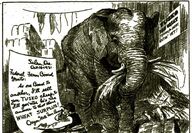
Under the light of a single bulb, in a big storage room at the University of Oregon's Museum of Natural and Cultural History in Eugene, are the bones of a famous onetime Oregonian named Ned. Ned had other names. On stage, he was billed as "Tusko the Magnificent," "Tusko the Terrible," or just plain "Tusko." Toward the end of his short life, he was known in the newspapers as "Tusko the Unwanted." But he always answered to Ned, and toward the end he started getting angry when people called him...
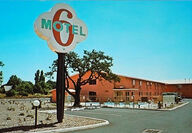
It was a few minutes after midnight on May 17, 1974, and the Oregon State Penitentiary employee sitting in his car outside the Salem Motel 6 was starting to get nervous. He was there to supervise a conjugal visit between a convicted cop killer named Carl Cletus Bowles and his fiancée, Joan Coberly, and the convict was supposed to have returned to the parking lot by midnight. He walked up to room 30, knocked on the door. No response. He went down and used the lobby telephone to call the room....

Dawn was just breaking, and Tom McAdams had just barely crawled into bed, when he got the alarm. A 50-foot sailboat was washing ashore near Waldport. McAdams had been up all night escorting a leaking fishing boat into port after it got caught in a bad storm 20 miles offshore. Now it was the morning of Dec. 13, 1973, and it was his wife Joanne's birthday. He'd planned on snatching four or five hours of sleep and then maybe doing something with Joanne. Instead, he was sprinting across the street t...
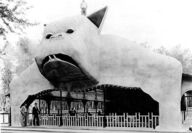
For a small group of Portland-area businessmen in 1929, opportunity was knocking - or so they thought. Jantzen Beach, the legendary swim-and-play amusement park on Hayden Island in the Columbia River, had opened in 1928 to vast sell-out crowds, and was doing very well there. It was backed by some deep pockets, and was a showplace for the Jantzen brand of swimwear. And the businessmen happened to own a large piece of real estate on the other side of the island - the easternmost tip of it, in...
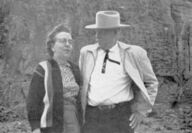
There was a time, and it was not too long ago, that the state of Oregon had something of a reputation as a place for great liars. Now, by "great liars," I mean tellers of the GOOD kind of lies, not the kind of lies various politicians are throwing around right now. I'm talking about the "Paul Bunyan, Casey Jones and Pecos Bill" kind of liars. One such "great liar" of honored memory is a lively Eastern Oregon fellow named Reub Long. You may recognize Reub's name if you've ever lived on the "dry...
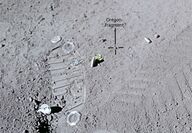
When the moon is full and hanging low in the sky over Central Oregon, take a good close look at it. In one of its craters, surrounded by tire tracks and boot prints and the abandoned "moon buggy," a tiny chunk of Oregon lies on its surface. Here's how it got there: Starting around 1964, NASA started sending future lunar astronauts to various unusual places to study volcanic geology and to familiarize themselves with landscapes that they thought they might encounter on the moon. Although...

All through the summer of 1973, there was one song on the radio everywhere that you just couldn't get away from: Jim Croce's smash hit, "Bad, Bad Leroy Brown." Come to think of it, it's been very difficult to get away from that song ever since Croce wrote it. You probably are humming it to yourself right now: "Bad, bad Leroy Brown, baddest man in the whole damn town. Badder than old King Kong, meaner than a junkyard dog." The little Cascade-foothills town of Boring once had its own Bad, Bad...

On a calm day in mid-September of 1930, a small steam schooner put out of Crescent City, Calif., bound for Coos Bay with a crew of 18 men and a 250-ton load of logs. It was never seen again. The ship was the S.S. South Coast. On that day, three decades into the 20th century, she was already a historic vessel. In a sense, she actually predated the steam schooner era - in 1887, when her keel was laid, all steam schooners were actually sailing ships retrofitted with steam engines. The South Coast...

It was around 1878 that newly-single Mary Leonard moved to Portland and set herself up as the proprietress of a boardinghouse in the North End waterfront district - the seediest, roughest neighborhood in Portland. Mary was in her early 30s, striking in appearance and more than a little notorious. She'd moved there from The Dalles, where she had just been acquitted of charges of sneaking into her estranged husband's bedroom one night and shooting him in the head while he slept. She'd spent a full...
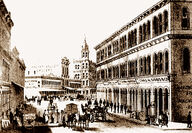
Most Oregon professional women can point to a truly amazing pioneer who opened her profession up to women. Physicans (physiciennes?) can look to Bethenia Owens-Adair, who, despite her now-embarrassing enthusiasm for eugenics, was a giant in her field. Journalists (journalistes?) have Abigail Scott Duniway, about whom little more needs to be said. But attorneys? Not so much - not, that is, if you believe the conventional wisdom on the subject. Oregon's first female attorney was a bit of an...
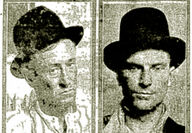
The sun had just gone down on a warm early-summer night, and the twilight was in the final stages of fading away when Union Pacific Railroad special agents Buck Phillips and H.G. Schneider stepped into the railroad yard to make the rounds. There had been some issues in the railyard. A gang of thieves had been systematically pillaging the railroad. Their M.O. was a simple one, and evidently pretty effective: they'd sneak aboard an outbound boxcar full of cigarettes and, while the train was en rou...

Sometime in 1915, a 40-year-old Black woman named Frankie Baker stepped off the train at Portland's Union Station. She had come to stay; Oregon would be her home for the rest of her life. At that time, Portland had a a reputation as a good place to hide out when you were on the lam. It was far off the beaten path; but the town had all the cultural perquisites of civilization, or most of them anyway. Plus, the people of Oregon had a reputation for minding their own business. So a lot of people wh...

By On February 20, 1931, a former Lincoln County commissioner named Elmer Calkins looked behind his tractor at the plow he was pulling and saw human bones strewn out along the furrow behind it. Calkins was working up a patch of land near the mouth of the Salmon River so that it could be flattened out into a smooth, park-like landscape for the summer camping resort he was building there. The new Roosevelt Highway - Highway 101 - was mostly built, and car-tripping tourists from the Willamette...
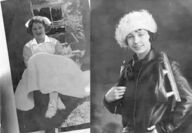
Annie-Sammy Oregon divorcee Agnes Anne “Annie” LeRoi arrived in Phoenix in the first few months of 1931 with her best friend and roommate, schoolteacher Hedvig “Sammy” Samuelson. They were climate refugees: Sammy had tuberculosis, and at the time the only cure for “consumption” was a dry climate and rest. Back then, many patients with TB waited until they were so far gone that the climate couldn’t save them; essentially, they moved to Arizona to die. Sammy wasn’t one of them; her case was mi...

It was the dark early-morning hours of Feb. 13, 1911, and off the north coast of Oregon the gasoline-powered motor schooner Oshkosh was in serious trouble. The Oshkosh was a coastwise cargo ship, but it wasn’t much bigger than a large yacht. It was 89 feet long and rated at just 145 tons. It was also nearly brand new, built in 1909 at the Kruse and Banks Shipyard in North Bend. The little freighter was only about a year and a half old. It would not see two. The Oshkosh had left Tillamook Bay a...
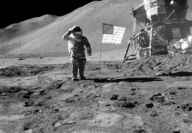
When the moon is full and hanging low in the sky over Central Oregon, take a good close look at it. In one of its craters, surrounded by tire tracks and boot prints and the abandoned "moon buggy," a tiny chunk of Oregon lies on its surface. Here's how it got there: Starting around 1964, NASA started sending future lunar astronauts to various unusual places to study volcanic geology and to familiarize themselves with landscapes that they thought they might encounter on the moon. Although...